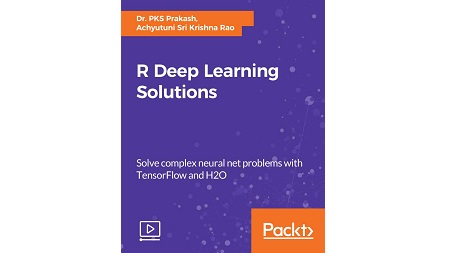
English | MP4 | AVC 1920×1080 | AAC 44KHz 2ch | 2h 36m | 644 MB
Powerful, independent videos to build deep learning models in different application areas using R libraries
Deep learning is the next big thing. It’s a part of machine learning. Its favorable results in applications with huge and complex data is remarkable. R programming language is very popular among data miners and statisticians.
This course will help you resolve problems during the execution of different tasks in deep learning, neural networks, and advanced machine learning techniques. We start with different packages in deep learning, neural networks, and structures. We’ll also encounter the applications in text mining and processing along with a comparison between CPU and GPU performance. It will also take you through complex deep learning algorithms and various deep learning packages and libraries in R.
By the end of the course, you’ll have an understanding of deep learning and different deep learning packages so you have the most appropriate solutions for your problems.
This collection of videos will act as your all-time reference for your deep learning needs.
What You Will Learn
- Build deep learning models in different application areas using TensorFlow and H2O
- Analyze a Deep Boltzmann machine
- Set up and analyze deep belief networks
- Build supervised model using various machine learning algorithms
- Set up variants of basic convolution function
- Represent data using Autoencoders
- Explore generative models available in Deep Learning
- Discover sequence modeling using Recurrent nets
- Understand the fundamentals of Reinforcement Learning
- Know the steps involved in applying Deep Learning in text mining
- Explore application of deep learning in signal processing
- Utilize transfer learning to utilize a pre-trained model
Table of Contents
01 The Course Overview
02 Installing R and Jupyter
03 Basics of Machine Learning in R
04 Installing TensorFlow and H2O in R
05 Performing Logistic Regression Using H2O
06 Performing Logistic Regression Using TensorFlow
07 Setting Up a Neural Network Using H2O
08 Tuning Hyper-Parameters Using Grid Searches in H2O
09 Setting Up a Neural Network Using TensorFlow
10 Downloading and Configuring an Image Dataset
11 Learning the Architecture of a CNN Classifier
12 Creating New Layers
13 Setting Up Autoencoders
14 Building and Comparing Stochastic Encoders and Decoders
15 Evaluating the Sparse Decomposition
16 Learning Manifolds from Autoencoders
17 Setting Up Denoising Autoencoders
18 Setting Up Stacked Auto encoders
19 Comparing PCA with the RBM
20 Setting Up an RBM for Bernoulli Distribution
21 Initializing and Starting a New TensorFlow Session
22 Setting Up an RBM for Collaborative Filtering
23 Setting Up a Deep Belief Network
24 Setting Up a Deep Restricted Boltzmann Machine
25 Implementing a Feed-Forward Backpropagation Neural Network
26 Setting Up a Basic Recurrent Neural Network
27 Setting Up a Bidirectional RNN Model
28 Setting Up a Deep RNN Model
29 Setting Up a Long Short-Term Memory Based Sequence Model
30 Setting Up a Markov Decision Process
31 Performing Model-Based Learning
32 Performing Model-Free Learning
33 Preprocessing of Textual Data and Extraction of Sentiments
34 Analyzing Documents Using tf-idf
35 Performing Sentiment Prediction Using LSTM Network
Resolve the captcha to access the links!